Zodiac History: Ancient Myths Behind Signs
There is a between ancient mythology and Zodiac signs and a fascinating story is hiding behind the name or image of each sign.
Discover Zodiac Mythology
Find out what myth your sign is based on!
The myth of Aries
Poseidon, the ancient Greek god of the sea, fell in love with a young nymph, Theophane. She was so beautiful that it was only natural that she had a lot of suitors. In an attempt to get rid of them, Poseidon hid her on the isle of Crinissa and turned the beauty into a sheep.
Then Poseidon metamorphosed himself into a ram. Poseidon and Theophane conceived a ram with the Golden Fleece. In Greek mythology, the Ram is famous for helping Nephele and her children, Phrixus and Helle, escape from Nephele’s ex-husband and his new wife, Ino, who tried to kill the twins.
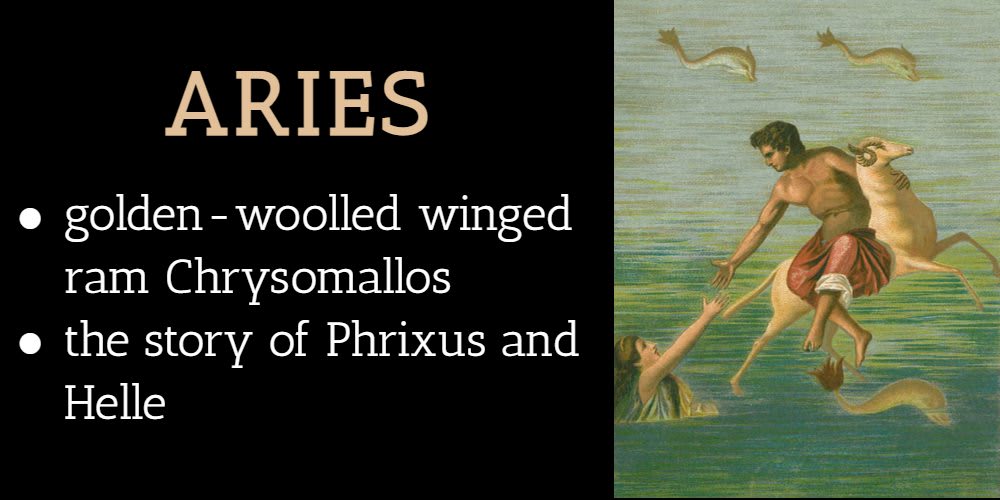
The myth of Taurus
The myth of Taurus is connected to Zeus, the sky and thunder god in ancient Greek mythology, and Europa, a Phoenician Princess. One day, Zeus saw Europa playing with her friends on the beach. Zeus became infatuated with the beautiful princess and decided to abduct her. The god turned himself into a mighty white bull to approach the beauty.
When Europa mounted the bull, he carried her off to Crete where they conceived three sons. Later, Europa fell in love and married Asterion, the King of Crete. Consequently, Zeus’s sons became the kings of Crete.
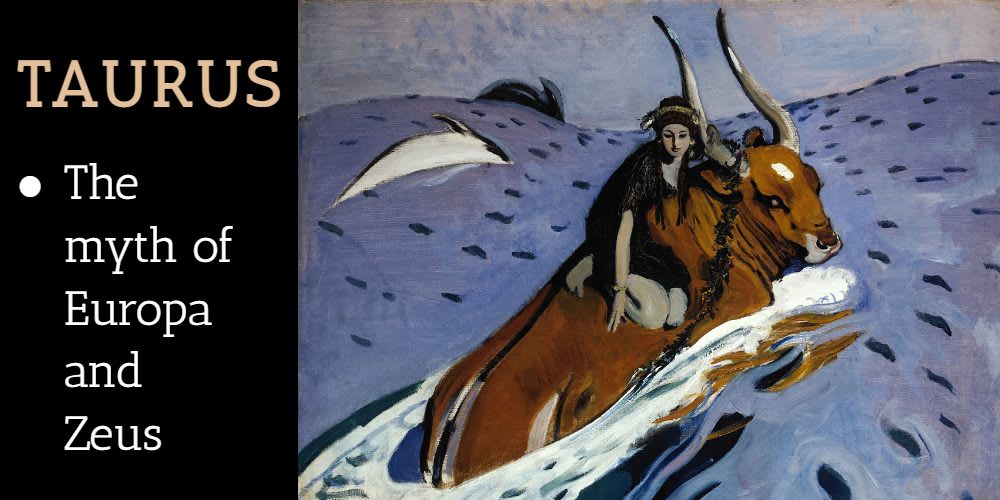
The myth of Gemini
The myth of Gemini is a myth of twin brothers, mortal Castor and immortal Pollux. The brothers were the sons of Zeus, the ancient Greek sky and thunder god, and Leda, the queen of Sparta and King Tyndareus’s wife. Leda seduced by mighty Zeus who metamorphosed himself into a swan then shared the bed with her husband, thus giving birth to two immortal and two mortal children.
The myth then focuses on the story of mortal Castor and immortal Pollux. When Castor was fatally wounded, Zeus offered Pollux to live with him on Mount Olympus as a god but the young man decided to share his immortality with the brother. Since then the twins had spent a day at Hades with the deceased and a day at Mount Olympus with gods.
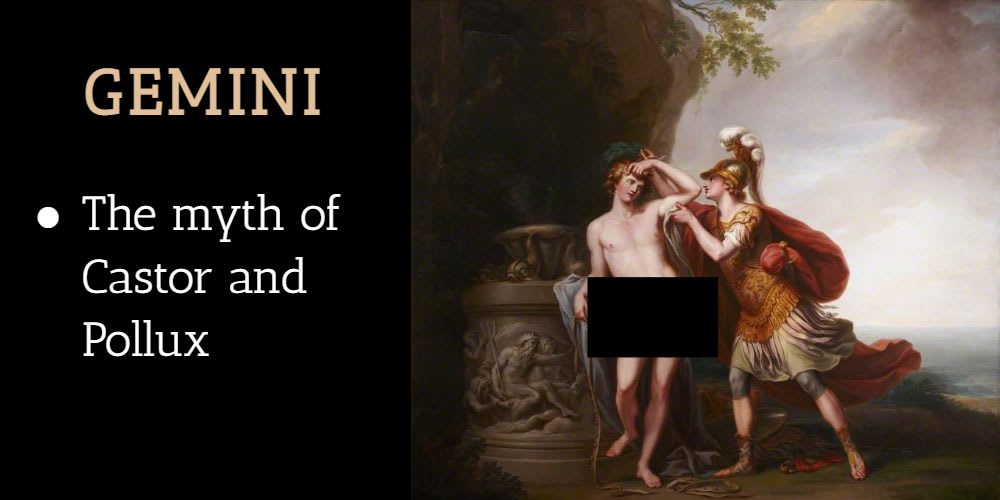
The myth of Cancer
The myth is related to Hercules who was famous for his incredible strength and eagerness to help mortal people protecting them from the wrath of ancient Greek gods. Hercules was the son of Zeus, the ancient Greek sky and thunder god, and Alcmene, a mortal woman. It’s only natural that Hera, Zeus’s wife, hated Hercules desiring his death.
Hera incited a crab to kill Hercules during his battle with the Lernaean Hydra. However, the brave crab managed only to pinch Hercules’s foot, after which the hero crushed the crab.
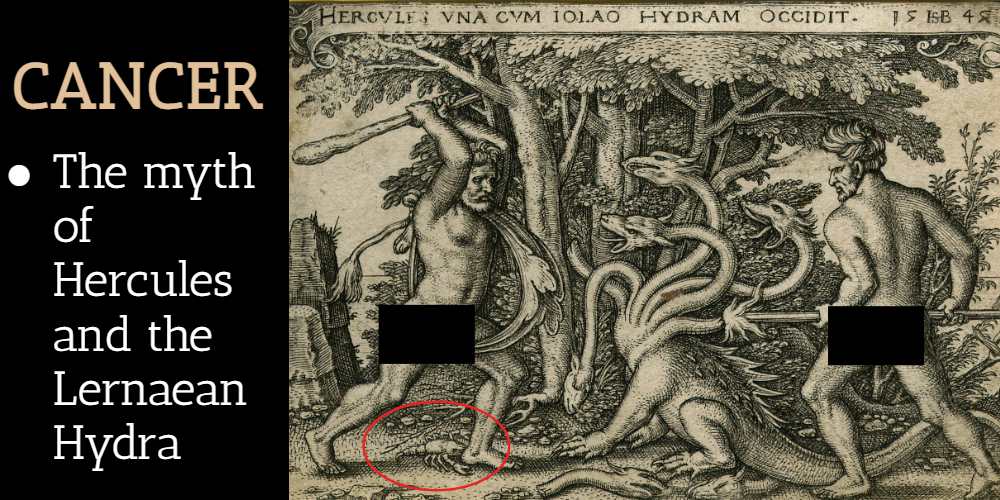
The myth of Leo
The Nemean Lion represents the Leo constellation. The Lion was a huge monster who lived near the village of Nemea. According to the myth, the Lion’s skin was immune to any weapon produced by mortal people; besides, it could tear any amour apart with its sharp claws.
The Nemean Lion was defeated by Hercules, the son of Zeus, the ancient Greek sky and thunder god. Hercules willing to kill the Lion entered his cave. It took him two month to trap the beast, after which Hercules strangled the Lion and made a cloak of its skin.
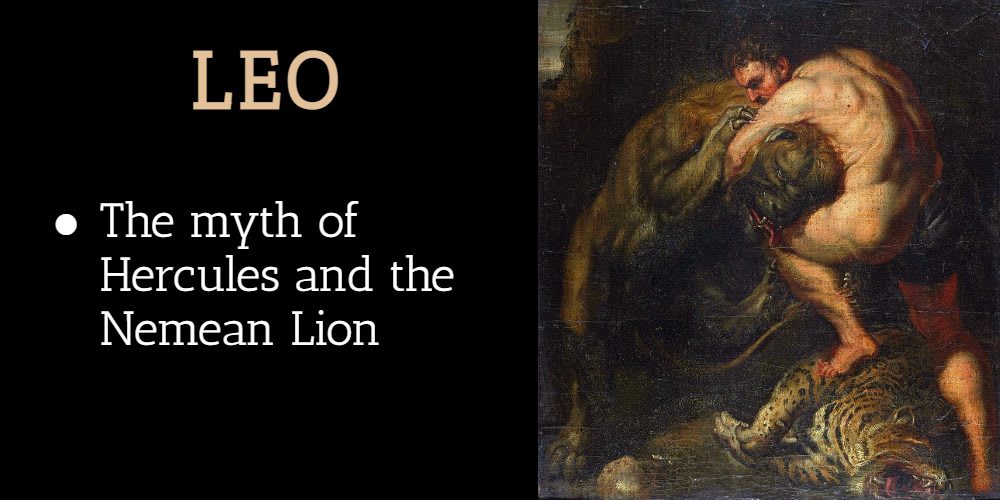
The myth of Virgo
The Virgo sign is traditionally associated with Demetres, an ancient Greek goddess of agriculture, or Ceres, an ancient Roman goddess of agriculture. However, there is another version that connects the Virgo constellation to Astraea, the daughter of Astraeus and Eos.
According to the myth, Astraea, an ancient Greek goddess of purity and virginity, lived with mortal people within the time period from the Golden Age, the period of harmony and peace, to the Iron Age, the period of decline. She became dismayed at the wickedness of people and abandoned the Earth becoming a constellation.
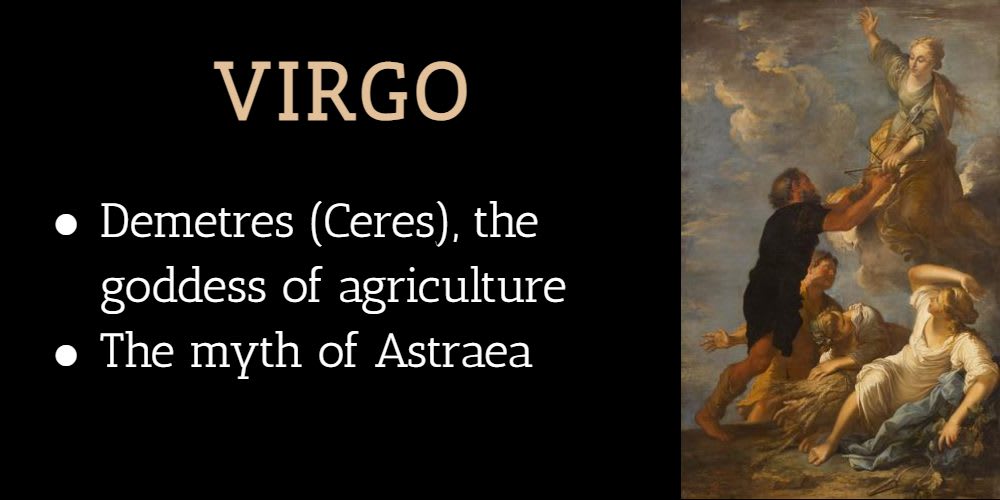
The myth of Libra
On the one hand, the Libra sign related to the myth of Astraea, an ancient Greek goddess of purity and virginity. On the other hand, the Libra constellation is made by the stars of Scorpio. Therefore, the Libra sign is often viewed as a link between the Virgo sign and the Scorpio sign.
Sometimes, the sign is associated with Dike who was the ancient Greek goddess of justice. Dike played a very important role since she weighed human souls – she punished sinners and rewarded those who were virtuous during their earthly life.
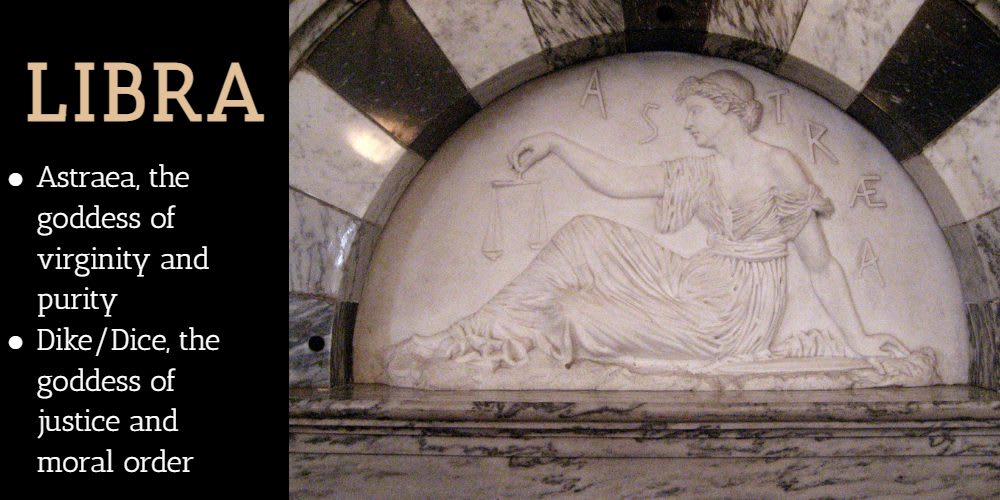
The myth of Scorpio
The myth of Scorpio is related to an ancient Greek hunter named Orion. Orion decided to hunt down every animal on the planet provoking the wrath of Artemis, the ancient Greek goddess of hunt and wilderness. Angry Artemis sent a scorpion to kill the hunter. Orion died after he was stung by the venomous scorpion.
Zeus transformed the scorpion and Orion into constellations and placed them in the sky as a reminder that excessive pride would be punished. When the Scorpio constellation appears above the horizon, the Orion constellation is already hidden below it resembling hunter Orion who fell dead stung by the scorpion.
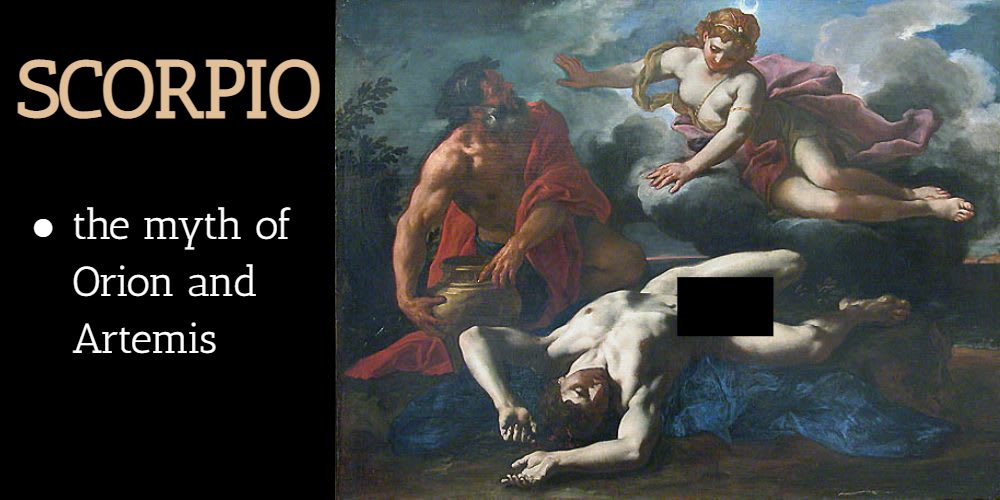
The myth of Sagittarius
On the one hand, the Sagittarius sign is associated with Crotus, the son of the notorious satyr Pan. Raised by Muses, Crotus was very talented – he was a brilliant musician and a good hunter. He was also described as a sharpshooter; therefore, he was credited with the invention of archery. To praise his archery skills, Zeus gave him a bow and an arrow and raised him to the stars.
On the other hand, the Sagittarius sign is believed to be related to Chiron, a wise centaur who was Achilles teacher and mentor. Chiron gave his immortality to Prometheus taking his place in Hades.
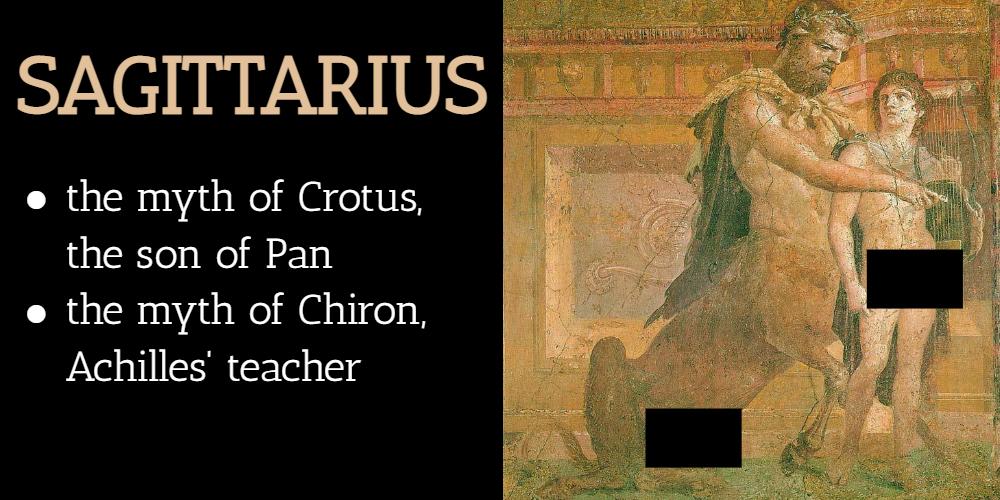
The myth of Capricorn
The Capricorn constellation is linked to a myth in which a satyr saved Zeus, the ancient Greek sky and thunder god. One day when Pan, a satyr with a torso of a human and legs of a goat, was entertaining ancient Greek gods, a vicious giant Typhon appeared.
While the gods could think of nothing better than turning themselves into various objects to save their lives, Pan jumped into the river to metamorphose himself into a creature with a torso of a goat and a fish tail making Typhon flee in panic.
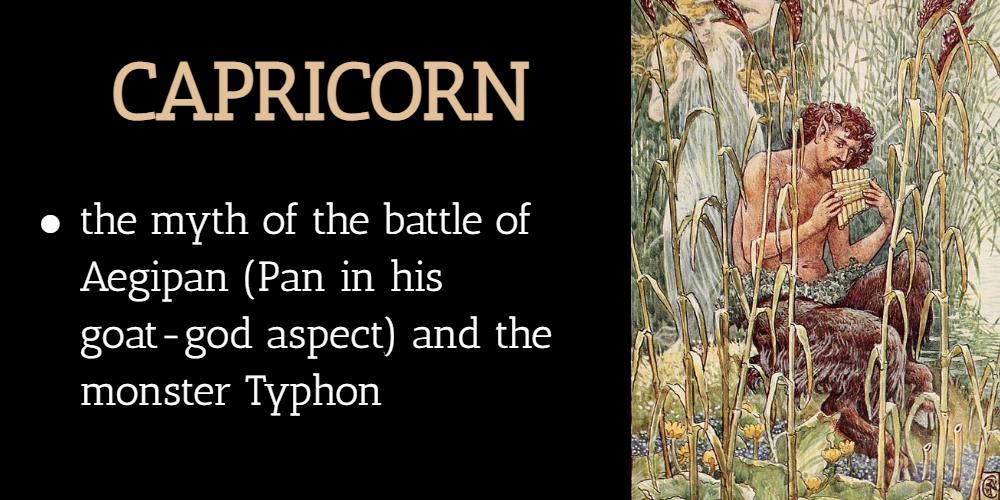
The myth of Aquarius
The constellation of Aquarius is related to the myth of Ganymede. Ganymede was described as the most handsome young man in the world. Zeus, the ancient Greek god of the sky and thunder, decided to take him to Mount Olympus where he would become his cupbearer.
Hera, Zeus’s wife didn’t approve of her husband’s decision since her daughter Hebe was Zeus’s cupbearer. Zeus who didn’t want to frustrate his wife could think of nothing better than to raise Ganymede to the stars as a constellation.
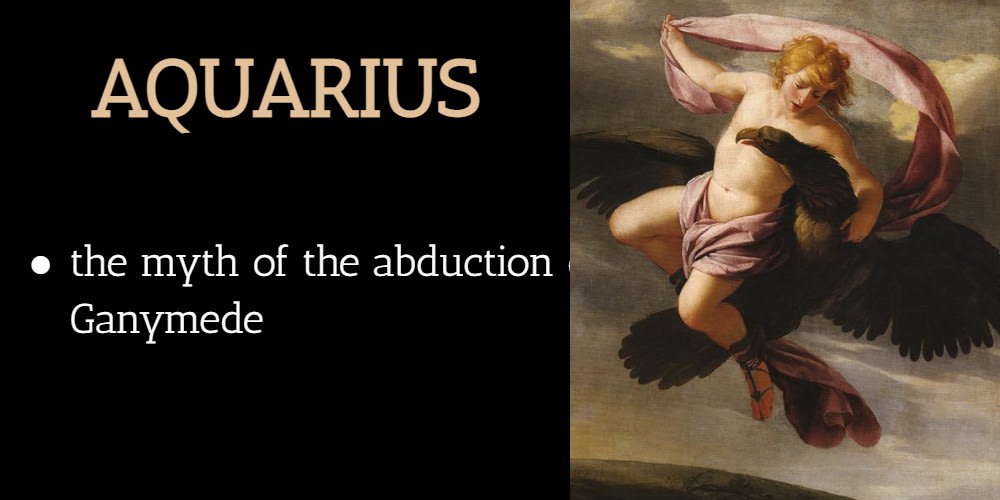
The myth of Pisces
According to one version, the Pisces sign is associated with Atagartis, the Syrian goddess of love and fertility, that was often represented as a mermaid. By a different version, the Pisces constellation is correlated with the myth of Aphrodite and her son Eros.
When Typhon, a vicious giant, attacked them on the banks of the river Euphrates in Syria, they jumped to the river to save their lives. In the river, Aphrodite and Eros turned themselves into fish to escape from furious Typhon.
